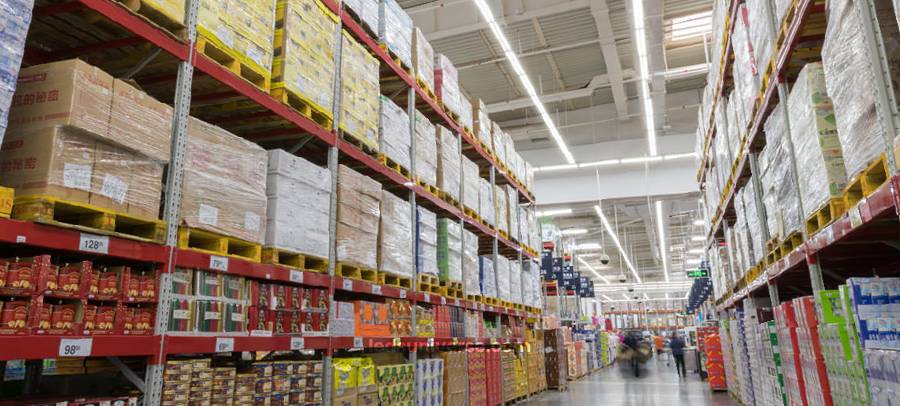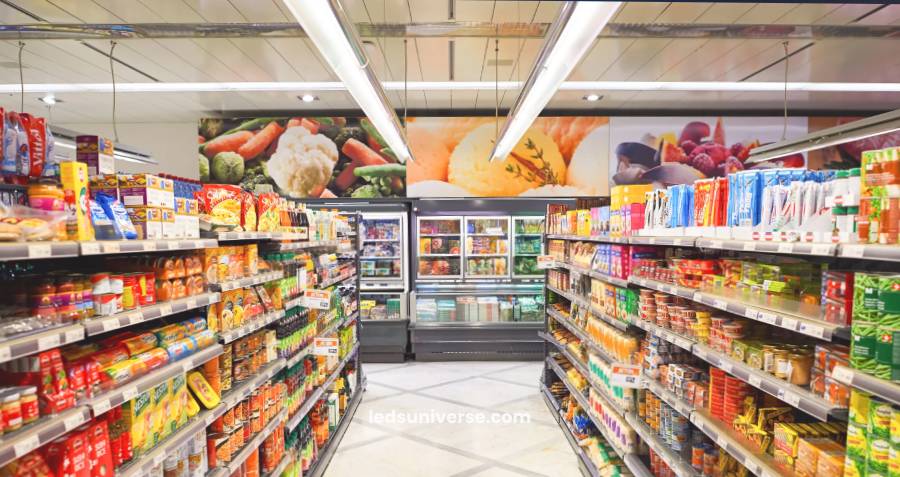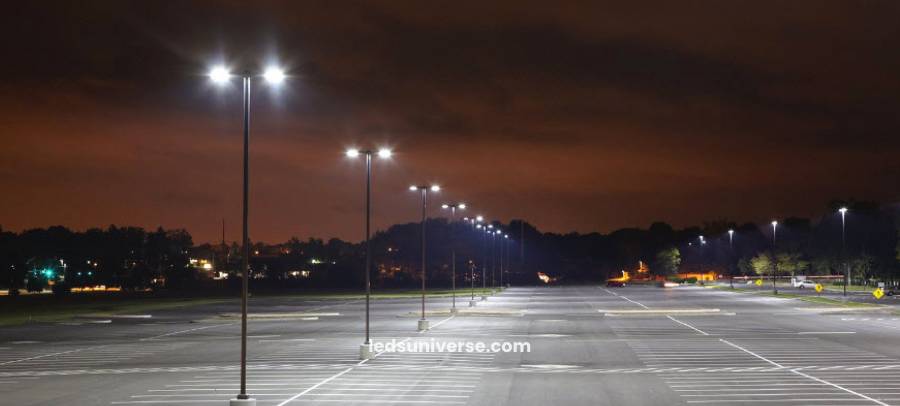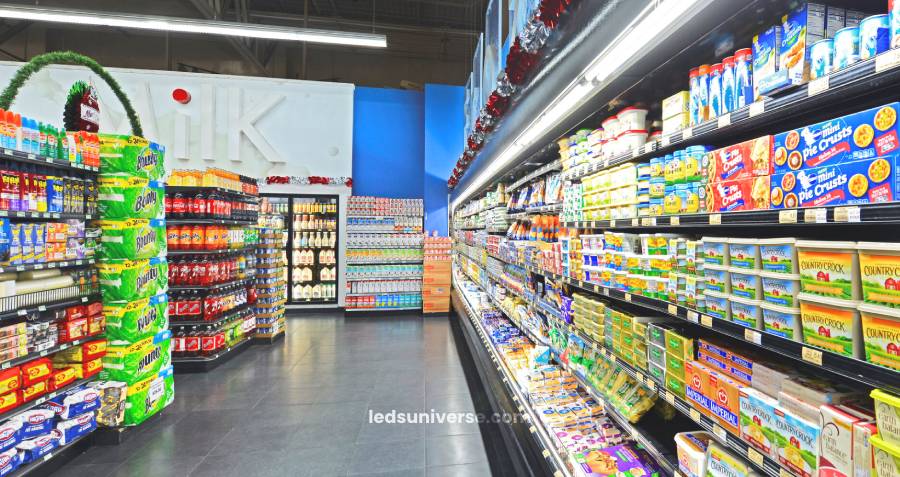Step into a space where lighting adjusts to your presence, enhancing comfort while saving energy. Modern commercial lighting is more than illumination—it’s smart, adaptive, and efficient.
From enhancing the work environment to ensuring safety, lighting in commercial spaces serves multiple purposes. Thoughtfully designed lighting systems not only improve the visual appeal of a space but also contribute to energy efficiency, reducing long-term operational costs. As businesses evolve, the demand for better lighting solutions continues to rise, driving innovation in technology and design.
Reach out for free lighting consultation
Table of Contents
ToggleLighting in commercial spaces is used for a variety of purposes, ranging from general illumination to specific task-based lighting. Different types of lighting cater to unique needs within the commercial environment.

Ambient lighting provides overall illumination for a commercial space, creating a comfortable level of brightness without overwhelming the environment. It ensures that areas such as lobbies, hallways, and workstations are well-lit, allowing individuals to navigate and perform tasks without strain. In many cases, ambient lighting is installed through overhead fixtures like recessed lights, chandeliers, or ceiling-mounted lamps. This type of lighting sets the general tone of the environment, whether it’s a calm and inviting atmosphere for customers or a functional and well-lit workspace for employees.
While ambient lighting illuminates large spaces, task lighting focuses on specific areas where detailed activities are performed. For example, in office environments, desk lamps or under-cabinet lights provide employees with the lighting they need to work on their tasks effectively. Similarly, in retail stores, task lighting is used to illuminate products on display, enhancing their visibility and appeal. Task lighting reduces the need for straining the eyes, making it a practical component of any well-designed commercial lighting plan.
Accent lighting highlights particular features or objects in a commercial space. Whether it’s artwork in a gallery, architectural details in a restaurant, or key product displays in a retail store, accent lighting draws attention to focal points. This type of lighting adds depth and dimension to the overall design, creating an engaging environment. Accent lighting is typically achieved through spotlights, track lights, or wall-mounted fixtures, strategically placed to direct light where it’s needed most.
Emergency lighting is crucial for safety, particularly in commercial environments that accommodate a large number of people. These lights ensure that occupants can safely exit a building in the event of a power failure or emergency. Emergency lighting is typically battery-powered and designed to automatically activate when regular lighting systems fail. It includes exit signs and pathway lighting that guides individuals to safety, making it an indispensable component of a comprehensive commercial lighting system.
LED lighting has transformed the commercial lighting landscape, offering a range of benefits that surpass traditional lighting options. As more businesses move towards sustainability and cost-effectiveness, LEDs have emerged as a popular choice for commercial lighting needs.

One of the primary advantages of LED lighting is its energy efficiency. LEDs consume significantly less power than traditional incandescent or fluorescent lights, making them an attractive option for businesses looking to reduce their electricity consumption. By using LEDs, commercial spaces can lower their energy bills while contributing to a reduced carbon footprint. LEDs are designed to convert most of the electrical energy they consume into light, minimizing energy waste through heat emission.
LEDs are known for their long lifespan, often lasting up to 50,000 hours or more. This extended lifespan translates to fewer replacements and reduced maintenance costs, which is particularly beneficial for large commercial spaces. Unlike traditional bulbs, LEDs do not burn out suddenly but gradually lose their brightness over time, providing businesses with more control over when to replace their lighting fixtures.
In addition to their energy-saving benefits, LEDs are also more environmentally friendly than traditional lighting options. They do not contain harmful chemicals like mercury, which is commonly found in fluorescent bulbs. As a result, LEDs are easier to recycle and do not pose environmental hazards when disposed of properly. Their energy efficiency also contributes to a reduction in greenhouse gas emissions, making them a sustainable choice for businesses aiming to minimize their environmental impact.
While the initial investment in LED lighting may be higher than other lighting types, the long-term savings are substantial. The reduced energy consumption and lower maintenance requirements associated with LEDs result in significant cost savings over time. For businesses that operate large spaces or require extensive lighting systems, these savings can be especially noticeable in the form of reduced utility bills and maintenance expenses.
When planning a commercial lighting system, several factors must be considered to ensure the lighting is effective and appropriate for the space. These design considerations help optimize the performance and functionality of the lighting while enhancing the overall experience for occupants.

The layout and spacing of lighting fixtures play a crucial role in ensuring even illumination across a commercial space. Poorly spaced lights can result in areas that are either too bright or too dim, leading to discomfort and reduced productivity. Designers must take into account the size of the space, the ceiling height, and the intended use of the area when determining where to place lights. In office settings, for instance, lighting should be evenly distributed to reduce glare on computer screens, while retail environments may require more targeted lighting to highlight specific products.
Color temperature is an important aspect of lighting design, influencing the mood and functionality of a space. Measured in Kelvin (K), color temperature ranges from warm to cool. Warm lighting (around 2700K to 3000K) creates a relaxed and cozy atmosphere, often used in hospitality settings such as restaurants and hotels. On the other hand, cool lighting (4000K to 5000K) promotes focus and productivity, making it ideal for offices, classrooms, and healthcare facilities. Choosing the right color temperature helps create an environment that aligns with the purpose of the space.
Advanced lighting control systems are becoming increasingly common in commercial settings, allowing businesses to manage their lighting more efficiently. These systems enable the integration of features such as dimming, motion sensors, and daylight harvesting, which adjusts lighting based on the amount of natural light entering the space. By automating lighting controls, businesses can reduce energy consumption and create a more comfortable environment for employees and customers alike. Moreover, smart lighting systems can be programmed to operate on specific schedules, further optimizing energy use.
The Color Rendering Index (CRI) measures a light source’s ability to reveal the true colors of objects as compared to natural light. In commercial spaces where accurate color representation is critical, such as retail stores or design studios, lighting with a high CRI (80 or above) is preferred. High-CRI lighting ensures that products appear true to their actual colors, improving customer perception and making spaces more visually appealing.
Commercial lighting is used across a variety of industries and environments, each with its unique requirements. The application of lighting in these spaces goes beyond mere illumination, contributing to the overall functionality and experience of the environment.
In office environments, lighting is a key factor in promoting employee well-being and productivity. Well-lit spaces reduce eye strain, fatigue, and headaches, creating a more comfortable work environment. LED lighting is a popular choice for offices due to its energy efficiency and ability to provide consistent, high-quality illumination. Task lighting, such as desk lamps, is often used in combination with ambient lighting to create a balanced lighting plan that meets the needs of office workers.
Lighting plays a significant role in retail environments, influencing how customers perceive products and make purchasing decisions. Bright, well-placed lighting can enhance product displays, drawing attention to specific items and creating a more appealing shopping experience. In addition to general lighting, retail stores often use accent lighting to highlight promotional displays or new products, encouraging customers to explore more of the store. Choosing the right color temperature and CRI is especially important in retail settings, as accurate color representation can impact how customers view products.

In large spaces like warehouses and industrial facilities, the primary goal of lighting is to ensure visibility and safety. High bay lighting is often used in these settings due to the height of the ceilings and the need for powerful, efficient illumination. LEDs are commonly used in warehouses because of their long lifespan and ability to provide bright, uniform light across large areas. Motion sensors and other smart lighting controls can further enhance energy efficiency by reducing lighting in areas that are not in use.
Restaurants and hospitality venues rely on lighting to create the desired ambiance and enhance the overall guest experience. Warm, dimmable lighting is often used to create a cozy and inviting atmosphere, while brighter lighting may be used in kitchens and service areas to ensure safety and efficiency. In hospitality settings such as hotels, lighting must balance functionality with aesthetics, ensuring that spaces are both visually appealing and easy to navigate for guests.
Healthcare facilities require precise and consistent lighting to support patient care and medical procedures. In areas like operating rooms or examination rooms, task lighting is used to provide focused illumination, ensuring that medical professionals can perform their duties accurately. Ambient lighting in patient rooms and waiting areas is typically designed to create a calming and comfortable atmosphere, promoting relaxation and recovery. LEDs are often chosen for healthcare environments due to their energy efficiency, long lifespan, and ability to provide high-quality, flicker-free light.
Energy efficiency is a growing concern for many businesses, driving the adoption of technologies and smart lighting solutions that reduce energy consumption while maintaining optimal lighting conditions. These innovations offer a range of benefits, from lower utility bills to improved sustainability.
Occupancy sensors are an effective way to reduce energy consumption in commercial spaces by automatically adjusting lighting based on the presence of people. When a space is occupied, the lights turn on, and when it is unoccupied, they turn off or dim to conserve energy. This technology is particularly useful in areas that are not consistently in use, such as conference rooms, restrooms, and storage areas. Occupancy sensors help businesses avoid wasting energy on lighting spaces that do not need continuous illumination.
Daylight harvesting systems use sensors to detect the amount of natural light entering a space and adjust artificial lighting accordingly. In areas with large windows or skylights, this technology can significantly reduce the need for electric lighting during daylight hours. By automatically dimming or turning off lights when there is sufficient natural light, businesses can lower their energy consumption and create a more pleasant, naturally lit environment. Daylight harvesting is particularly effective in office spaces, retail stores, and other environments where natural light is abundant.
Dimmable lighting systems allow businesses to adjust the brightness of their lights based on the time of day, the level of activity, or the desired ambiance. This flexibility not only enhances the user experience but also contributes to energy savings. In settings like restaurants, theaters, and hotels, dimmable lighting can be used to create different moods or atmospheres, while in office environments, it can help reduce eye strain and create a more comfortable workspace. By using dimmers, businesses can avoid over-lighting spaces and reduce their energy usage.
Programmable lighting controls enable businesses to automate their lighting systems based on specific schedules or occupancy patterns. Lights can be programmed to turn on and off at certain times of the day, reducing the need for manual intervention and ensuring that energy is not wasted. This is particularly useful for businesses that operate 24/7 or have varying hours of operation. Programmable controls can be integrated with other smart building systems, such as HVAC, to further optimize energy efficiency and create a cohesive building management system.
Many businesses seek grants to support the implementation of energy-efficient lighting systems. These grants can help offset the cost of upgrading to LED lighting or integrating smart lighting controls, making the transition to more sustainable lighting more affordable.
In many countries, government programs offer financial incentives for businesses that invest in energy-efficient lighting. These grants aim to reduce energy consumption, promote sustainability, and support businesses in reducing their carbon footprint. Government grants are typically available to a wide range of industries, from small businesses to large corporations, and can cover a portion of the cost of purchasing and installing energy-efficient lighting systems.
Utility companies often provide grants or rebates to businesses that adopt energy-saving technologies, including LED lighting and smart lighting controls. These programs are designed to encourage businesses to reduce their energy consumption, helping utility companies meet their energy-saving goals. By working with their utility provider, businesses can take advantage of these financial incentives to reduce the upfront cost of upgrading their lighting systems.
Some industries may have access to specialized grants that support the implementation of energy-efficient lighting. For example, the hospitality industry may be eligible for grants that focus on improving sustainability in hotels and restaurants. Similarly, industrial facilities may have access to grants that promote the use of energy-efficient lighting in manufacturing and warehousing operations. These industry-specific grants provide targeted support, helping businesses in specific sectors reduce their energy consumption and improve their sustainability efforts.
Applying for grants to support commercial lighting upgrades typically involves submitting a detailed proposal outlining the project’s scope, the expected energy savings, and the overall environmental impact. Businesses may be required to provide information about their current lighting system, the proposed upgrades, and how the new system will contribute to reduced energy consumption. By demonstrating the long-term benefits of energy-efficient lighting, businesses can increase their chances of securing grants to support their projects.
Proper maintenance is essential to ensure the longevity and performance of commercial lighting systems. Regular inspections, cleaning, and timely replacement of components can help extend the life of the lighting system and ensure that it continues to operate efficiently.
Dust and debris can accumulate on lighting fixtures over time, reducing their effectiveness and brightness. Regular cleaning of fixtures helps maintain optimal light output and ensures that the space remains well-lit. In addition to cleaning, it’s essential to check for any signs of wear or damage, such as flickering lights or discolored bulbs, which could indicate the need for replacement.
Even with the long lifespan of LED lights, eventual replacement is inevitable. Businesses should keep track of the age of their lighting systems and replace bulbs or fixtures as needed to avoid interruptions in service. Replacing outdated lighting systems with newer, more energy-efficient models can also help reduce maintenance costs and improve the overall performance of the lighting system.
For larger commercial spaces, professional maintenance services can provide comprehensive lighting system inspections and repairs. These services ensure that the lighting system remains in peak condition, addressing any issues before they become major problems. Regular maintenance checks can also identify opportunities for further energy savings, such as upgrading to more advanced lighting controls or replacing older fixtures with more efficient models.
In addition to regular maintenance, ongoing monitoring of the lighting system can help businesses identify inefficiencies or potential problems before they escalate. With smart lighting systems, businesses can use data to track energy consumption, identify areas where lighting is used unnecessarily, and optimize the system for better performance.
As lighting technology continues to advance, periodic upgrades may be necessary to maintain the efficiency and effectiveness of the lighting system. For example, transitioning to newer LED technologies or upgrading control systems to integrate with building automation platforms can provide additional energy savings and enhance the overall functionality of the lighting system.
Emergency lighting systems, required by many safety codes, must also be regularly inspected and maintained. These systems ensure that occupants can safely evacuate the building during a power outage or other emergencies. Backup lighting, such as battery-operated or generator-powered systems, should be tested frequently to ensure they are fully operational in case of an emergency.
By staying proactive with maintenance and keeping systems up to date, businesses can ensure that their commercial lighting remains reliable, energy-efficient, and compliant with safety regulations.
The future of commercial lighting is centered around increased energy efficiency, enhanced user control, and integration with broader smart building systems. Technological advancements are driving innovation in the lighting industry, with new solutions offering improved performance, sustainability, and flexibility.
The integration of lighting systems with the Internet of Things (IoT) is transforming how businesses manage their lighting. IoT-enabled lighting systems can communicate with other building systems, such as HVAC, security, and occupancy sensors, to create a fully connected and intelligent environment. These systems can automatically adjust lighting based on real-time data, such as occupancy levels, natural light availability, and energy usage patterns, optimizing both comfort and energy efficiency.
With IoT integration, businesses can also gain access to valuable data analytics that provide insights into how lighting is being used throughout the building. This data can be used to further optimize energy usage, reduce costs, and enhance the overall user experience.
Human-centric lighting (HCL) is an emerging trend that focuses on the impact of lighting on human health, well-being, and productivity. By mimicking natural light patterns, HCL systems can support circadian rhythms, improve mood, and enhance cognitive function. In commercial environments, such as offices and educational institutions, HCL can improve worker performance and create a more comfortable, supportive environment.
HCL systems use tunable white LED technology, allowing the color temperature and brightness of the lighting to be adjusted throughout the day to align with natural daylight patterns. For example, cooler, brighter light in the morning can help increase alertness, while warmer, dimmer light in the evening can promote relaxation and prepare the body for sleep.
As sustainability becomes a top priority for businesses, lighting systems are evolving to minimize their environmental impact. This includes the use of recyclable materials, energy-efficient technologies, and sustainable manufacturing practices. Companies are increasingly choosing lighting solutions that not only reduce energy consumption but also have a lower carbon footprint.
In addition, solar-powered lighting systems are gaining traction, especially in outdoor commercial applications such as parking lots, walkways, and signage. These systems rely on renewable energy sources, further reducing the environmental impact of commercial lighting.
The future of commercial lighting includes even more sophisticated control systems that offer greater customization and flexibility. Advanced lighting controls allow businesses to fine-tune every aspect of their lighting environment, from adjusting the color temperature to setting up intricate lighting schedules based on occupancy patterns or business needs.
These systems also include voice-activated controls, mobile app integrations, and seamless connection to broader building management platforms. The goal is to give businesses greater control over their lighting while maximizing energy savings and user satisfaction.
While LED lighting is already highly energy-efficient, future developments will push the boundaries of what is possible. New LED technologies are being developed to offer even higher luminous efficacy (more lumens per watt), further reducing energy consumption. These advancements, combined with improved thermal management and reduced heat emission, will make commercial lighting systems even more cost-effective and environmentally friendly.
The role of lighting in supporting mental and physical health is gaining increased attention. Beyond just human-centric lighting, businesses are looking to create environments that support wellness by using lighting to reduce stress, enhance mood, and promote better sleep. This includes personalized lighting systems that adapt to individual preferences, further integrating well-being into the lighting design process.
Commercial lighting continues to evolve, offering businesses new opportunities to improve energy efficiency, enhance user experience, and create smarter, more sustainable environments. From the adoption of LED lighting to the integration of advanced control systems and IoT connectivity, businesses have a wide range of options to optimize their lighting systems. Proper maintenance, the pursuit of grants, and staying ahead of technological trends will ensure that commercial lighting remains a valuable asset, contributing to cost savings, sustainability, and occupant well-being for years to come.